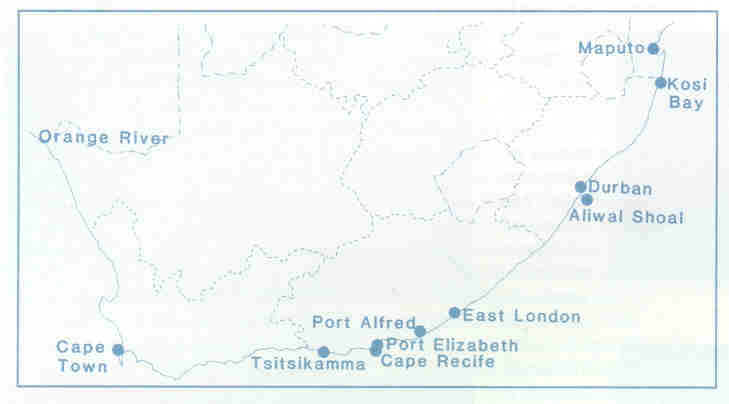
Species of three of the six families of blennioid fishes occur in South African waters: true blennies (Family Blenniidae), klipfishes (Clinidae) and triplefins (Tripterygiidae).
Triplefins are found in all temperate and tropical waters of the world. They are easily identified by their three dorsal fins, from which they derive their name, Tripterygiidae, based on the Genus Tripterygion (from tri, three, and pterygion, a fin). They are, however, seldom seen because they are generally small, cryptically coloured, benthic (bottom) dwellers which live amongst algae and anything else attached to rocks, under ledges, and in every nook and cranny imaginable.
There are more than a hundred species of triplefins worldwide, with about 23 species in the Western Indian Ocean, of which 11 occur in South African waters, and of these, eight species can be said to be East Coast inhabitants, bearing in mind, of course, that our knowledge of the diversity and distribution of our marine fishes is far from perfect. In other words, there may well be unrecorded or undescribed species along our coast, particularly in deeper waters.
As one moves from temperate to tropical areas, the species composition of the ichthyofauna changes and species diversity increases. Also, more ‘isolated’ areas – and that is a relative term – are more likely to have ‘endemic’ species, which are confined to a particular geographic area and do not occur elsewhere. South African triplefins illustrate these points quite nicely.
The temperate southern Cape coast, from a little north of East London, where the tropical fish fauna becomes more apparent, to about the Orange River mouth on the west coast, can be considered an ‘isolated’ area. There are about 88 endemic species of fishes, including three triplefins, along this south coast area.

The Cape triplefin, Cremnochorites
capensis, is known from False Bay to Coffee Bay. It grows to
about 120 mm, is rough and scaly and banded grey in colour with bits of
rusty-orange. It is found fairly commonly in sub-tidal rocky gullies
down to about 30 m.

Cremnochorites capensis,
70 mm.
Two new species, Acanthanectes hystrix and Acanthanectes rufus were described by myself and Colin Buxton in 1993 from collections made in 10 to 24 m at Port Elizabeth and the Tsitsikamma National Park. A new genus, Acanthanectes (from acanth, a thorn or spine, and nektes, a swimmer); was created for these species, because these two species have several little spinelets on each side of the dorsal-fin spines and also on the subopercle bones.
Acanthanectes hystrix
(hystrix is the Latin name for a porcupine) is similar to Cremnochorites
capensis, with 4 or 5 conspicuous, irregular, dark bars on the body
and 4 spines in the first dorsal fin.

Dorsal-fin spines from
Acanthanectes species.
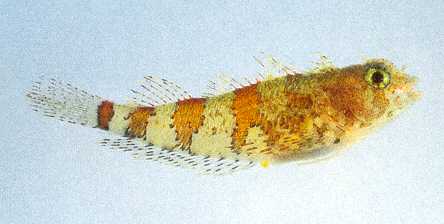
Acanthanectes hystrix,
37 mm.
Acanthanectes rufus,
is pale orange-red, with 5 or 6 narrow, palebars on the upper part of the
body. It was also found at Port Alfred.

Acanthanectes rufus,
42 mm.
These three south coast
endemic triplefins have not been collected north of Port Alfred.
Moving north of East London,
we find the hotlips triplefin, Helcogramma obtusirostre, abundant
in weedy tide pools and on shallow reefs from the Transkei to the Red Sea,
across the Indian Ocean and into the Western Pacific. It grows to
about 45 mm. Adult males are dark brown to black, with scarlet on
the head and first dorsal fin and crimson and neon blue on the lips and
pectoral-fin base.

Helcogramma obtusirostre,
male, 43 mm.
It has been suggested that the very dark males are in full breeding dress and may have a ‘harem’ of females. This is not uncommon amongst reef fishes. The dark colouration, particularly a dark or black head is quite common for male triplefins.
The female hotlips is, by
contrast, drab, mottled and blotched with cream and brown.
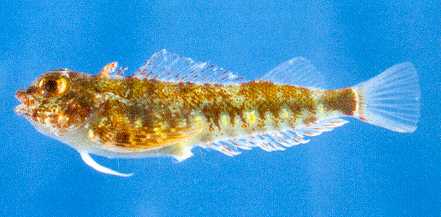
Helcogramma obtusirostre,
female, 41 mm.
Little is known about the
behaviour of these small fishes, and some interesting observations could
be made by a keen and patient Fish-Watcher who is prepared to lie quietly
in a warm tide pool with mask and snorkel to see what they get up to.
At Coffee Bay and northwards we find a second Helcogramma species, the blackfin triplefin, H. fuscopinna, with dark fins (fuscus, dark or dusky, and pinna, fin) and a brilliant neon-blue line from upper lip, below eye and onto opercle (gill cover). It is one of a complex of species found all the way to Melanesia in the Western Pacific.

Helcogramma fuscopinna,
48 mm.
In tidepools and diving
on reefs in KwaZulu-Natal, you will encounter six more triplefin
species.
The rough-head triplefin,
Norfolkia brachylepis (Schultz) resembles Cremnochorites capensis
(banded grey and russet, with 4 spines in the first dorsal fin), but it
is smaller and more slender, and the tentacle on top of the eye is simple
or crenulate (orbital tentacle branched in Cremnochorites).
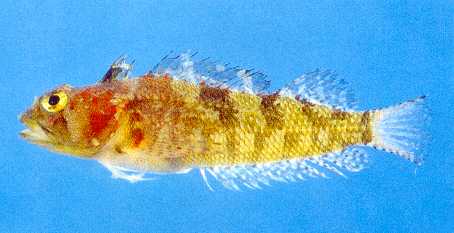
Norfolkia brachylepis,
55 mm.
N. brachylepis occurs from Aliwal Shoal northwards, and is also widely distributed in the Indo-West Pacific area. Norfolkia springeri (the name used in Smiths’ Sea Fishes) is a junior synonym of this species.
The five species of the genus Enneapterygius along our east coast are usually less than 30 mm and highly cryptic. They all live sub-tidally, but may also be found in tidepools.
The yellow triplefin, Enneapterygius
abeli, is bright yellow, and males have a black head. It is found
from Aliwal Shoal north to the Red Sea and widely in the Indian Ocean.
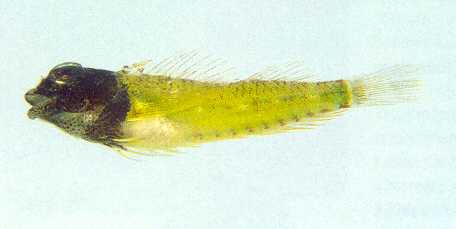
Enneapterygius abeli,
28 mm.
The blotched triplefin,
E. ventermaculus, is mottled orange-brown and light green; the underside
of the head and pelvic fins white, and there is a row of 4 black spots
on the anal fin base. It is endemic to the Western Indian Ocean
from Aliwal Shoal to Pakistan.
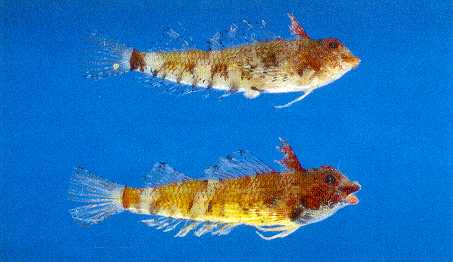
Enneapterygius ventermaculus,
female, 29 mm (above), male, 31 mm (below).
At Sodwana Bay, we find three additional species of Enneapterygius: the multicoloured E. pusillus, the barred triplefin, E. clarkae, and an as yet unnamed species, which was collected a few years ago near Kosi Bay on a flat, current-swept reef at 35 metres.
The multicoloured ‘high-crest
triplefin’,
Enneapterygius. pusillus, has the first dorsal fin distinctly
higher than the second dorsal fin; the pelvic fins are black, and the second
dorsal and anal fins are dusky. It occurs from Sodwana Bay to the
Red Sea.
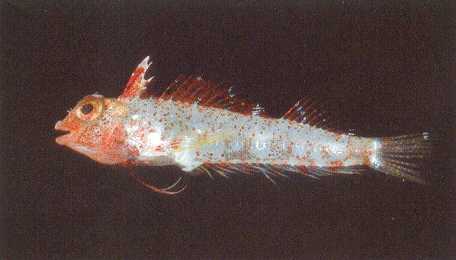
Enneapterygius pusillus,
31 mm.
The barred triplefin, Enneapterygius
clarkae, has 4 or 5 dark bars on the body, the last at the base of
the tail fin and a row of 5 or 6 dark spots along the anal-fin base.
Known from Sodwana Bay, but not common in our area; also
in Red Sea and at islands in Western Indian Ocean.
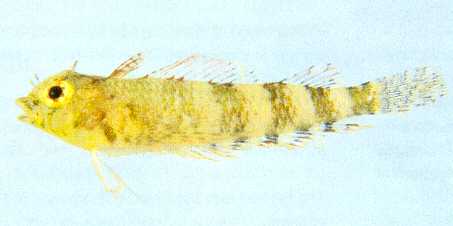
Enneapterygius clarkae,
28 mm.
Let us recap briefly. Three species of triplefin are endemic to the southern Cape coast. On the east coast, north of East London, we find Helcogramma obtusirostre and H. fuscopinna. In the Umkomaas area of KwaZulu-Natal, there are an addtional three species in two genera; and eight species of triplefin are known from Sodwana Bay.
This illustrates quite neatly endemicity in geographically ‘isolated’ areas, the change in species composition as one moves from cooler to warmer waters, and the increase in species diversity as one moves towards the tropics.